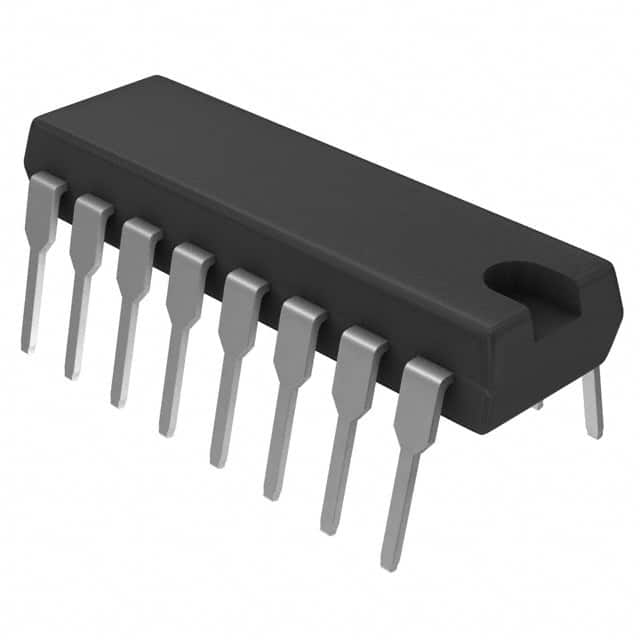Voir les spécifications pour les détails du produit.

CD74HCT4052E
Product Overview
Category
CD74HCT4052E belongs to the category of integrated circuits (ICs).
Use
It is commonly used as a multiplexer/demultiplexer in electronic circuits.
Characteristics
- High-speed CMOS logic technology
- Low power consumption
- Wide operating voltage range
- High noise immunity
- Compatible with TTL inputs
- Available in various package options
Package
CD74HCT4052E is typically available in a 16-pin DIP (Dual In-line Package) or SOIC (Small Outline Integrated Circuit) package.
Essence
The essence of CD74HCT4052E lies in its ability to select one of multiple input signals and route it to a single output line, or vice versa.
Packaging/Quantity
CD74HCT4052E is usually packaged in reels or tubes, with quantities varying depending on the manufacturer and distributor.
Specifications
- Supply Voltage: 2V to 6V
- Input Voltage: 0V to VCC
- Output Voltage: 0V to VCC
- Operating Temperature Range: -40°C to +85°C
- On-state Resistance: 70Ω (typical)
- Channel-to-channel Crosstalk: -80dB (typical)
Detailed Pin Configuration
CD74HCT4052E has a total of 16 pins, which are assigned specific functions. The pin configuration is as follows:
- S0: Select Input 0
- S1: Select Input 1
- Enable: Enable Input
- Common: Common Terminal
- I/O0: Input/Output Channel 0
- I/O1: Input/Output Channel 1
- GND: Ground
- I/O2: Input/Output Channel 2
- I/O3: Input/Output Channel 3
- VCC: Supply Voltage
- I/O4: Input/Output Channel 4
- I/O5: Input/Output Channel 5
- S2: Select Input 2
- S3: Select Input 3
- I/O6: Input/Output Channel 6
- I/O7: Input/Output Channel 7
Functional Features
- CD74HCT4052E is a dual 4-channel analog multiplexer/demultiplexer.
- It allows for bidirectional signal flow, enabling both analog and digital applications.
- The device has an enable input pin that can be used to disable all the switches simultaneously.
- CD74HCT4052E exhibits low ON-state resistance and low leakage current, ensuring minimal signal distortion.
Advantages and Disadvantages
Advantages
- High-speed operation
- Low power consumption
- Wide voltage range compatibility
- Excellent noise immunity
- Easy integration with TTL logic circuits
Disadvantages
- Limited number of channels (8 channels in total)
- May require additional external components for certain applications
Working Principles
CD74HCT4052E operates based on the principle of analog multiplexing and demultiplexing. When the appropriate select inputs (S0-S3) are activated, the corresponding channel is connected between the common terminal and the input/output terminal. This allows the user to route signals from multiple sources to a single destination or vice versa.
Detailed Application Field Plans
CD74HCT4052E finds applications in various fields, including:
- Audio and Video Switching Systems: Used to select different audio/video sources for output.
- Data Acquisition Systems: Enables the selection of different sensors or data sources for measurement.
- Communication Systems: Facilitates the routing of signals in telecommunication networks.
- Industrial Automation: Used for signal routing and control in automated systems.
- Test and Measurement Equipment: Allows for the selection of different test signals or measurement inputs.
Detailed and Complete Alternative Models
Some alternative models to CD74HCT4052E include:
- CD4052BE: Similar functionality, but operates at a wider supply voltage range (3V to 18V).
- 74HC4052: Compatible with CMOS and TTL logic levels, with similar specifications.
- CD74HC4067: A 16-channel analog multiplexer/demultiplexer with enhanced features.
These alternative models can be considered based on specific project requirements and availability.
Word count: 554 words
Énumérez 10 questions et réponses courantes liées à l'application de CD74HCT4052E dans les solutions techniques
Sure! Here are 10 common questions and answers related to the application of CD74HCT4052E in technical solutions:
Q: What is CD74HCT4052E? A: CD74HCT4052E is a multiplexer/demultiplexer integrated circuit (IC) that allows for the selection of one of four input signals to be routed to a single output.
Q: What is the purpose of CD74HCT4052E? A: The purpose of CD74HCT4052E is to provide signal routing and selection capabilities in various electronic applications, such as audio/video switching, data acquisition systems, and communication devices.
Q: How many input channels does CD74HCT4052E have? A: CD74HCT4052E has four input channels, which means it can select from up to four different input signals.
Q: Can CD74HCT4052E handle analog signals? A: Yes, CD74HCT4052E can handle both analog and digital signals, making it suitable for applications that require switching or routing of either type of signal.
Q: What is the voltage range supported by CD74HCT4052E? A: CD74HCT4052E supports a wide voltage range, typically from 2V to 10V, making it compatible with various logic families and power supply voltages.
Q: How is CD74HCT4052E controlled? A: CD74HCT4052E is controlled using control pins, such as the enable pin and the select pins, which determine the input channel to be selected.
Q: Can CD74HCT4052E be cascaded to increase the number of input channels? A: Yes, CD74HCT4052E can be cascaded by connecting the output of one IC to the input of another, allowing for the expansion of the number of input channels.
Q: What is the maximum frequency at which CD74HCT4052E can operate? A: CD74HCT4052E has a maximum operating frequency of around 25 MHz, making it suitable for many high-speed applications.
Q: Does CD74HCT4052E have built-in protection features? A: Yes, CD74HCT4052E has built-in electrostatic discharge (ESD) protection on all pins, providing robustness against static electricity and other transient events.
Q: Are there any alternative ICs to CD74HCT4052E with similar functionality? A: Yes, some alternative ICs with similar functionality include CD74HC4051, CD4053, and 74HC4067. These ICs may have slightly different specifications and pinouts, so it's important to consult their datasheets for specific details.
Please note that these answers are general and may vary depending on the specific application and requirements. It's always recommended to refer to the CD74HCT4052E datasheet for accurate and detailed information.

